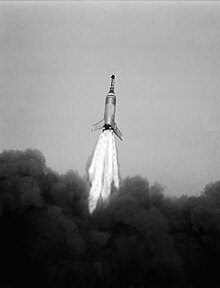Mercury-Little-Joe 6
| Missionsdaten | |||
|---|---|---|---|
| Mission: | Little Joe 6 (LJ-6) | ||
| Trägerrakete: | Little Joe | ||
| Start: | 4. Oktober 1959 | ||
| Startplatz: | Wallops Flight Facility, Virginia | ||
| Landung: | 4. Oktober 1959 | ||
| Landeplatz: | Atlantik | ||
| Flugdauer: | 5 min 10 s | ||
| Erdumkreisungen: | atmosphärischer Flug | ||
| Apogäum: | 59,5 km | ||
| Zurückgelegte Strecke: | 127 km | ||
| Maximale Geschwindigkeit: | 4949 km/h | ||
| Maximale Beschleunigung: | 5,9 g | ||
| ◄ Vorher / nachher ► | |||
| |||
Mercury-Little-Joe 6 war ein unbemannter Testflug innerhalb des Mercury-Programms der NASA. Der Flug diente der Erprobung der Rettungsrakete, die sich auf dem nicht funktionstüchtigen Modell der Mercury-Kapsel befand. Die Kapsel flog rund 127 km weit und erreichte bei 59,5 km Höhe den Gipfelpunkt. Die Maximalgeschwindigkeit betrug 4.949 km/h, die Maximalbeschleunigung 5,9 g. Die Nutzlast wog 1.134 kg.
Weblinks
- Little Joe 6 auf AstroLink.de
- LJ-6. In: Project Mercury Uncrewed Missions. NASA, abgerufen am 25. März 2017 (englisch).
Auf dieser Seite verwendete Medien
Launching of the LJ6 Little Joe on Oct. 4, 1959 took place at Wallops Island, Va. This was the first attempt to launch an instrumented capsule with a Little Joe booster. Only the LJ1A and the LJ6 used the space metal/chevron plates as heat reflector shields, as they kept shattering.
Mercury Program insignia
- Retroactive logo designed from 1964 Mercury Seven astronaut memorial
- Circle containing the astronomical symbol for planet Mercury, with the numeral 7 inside it



